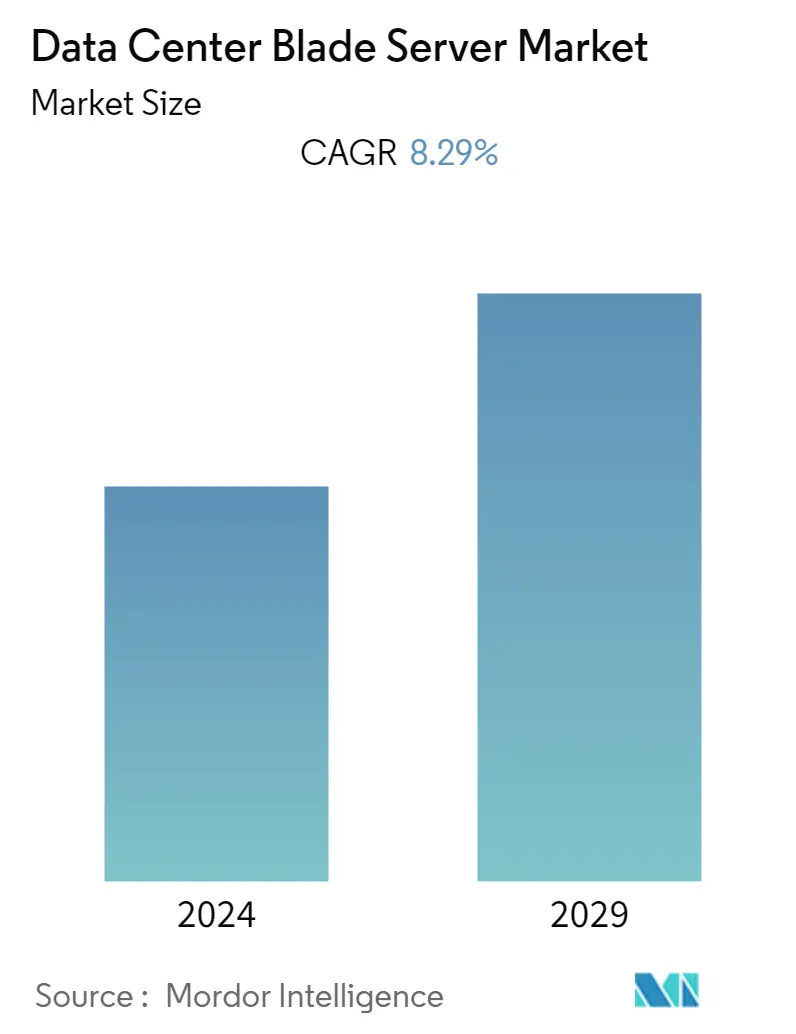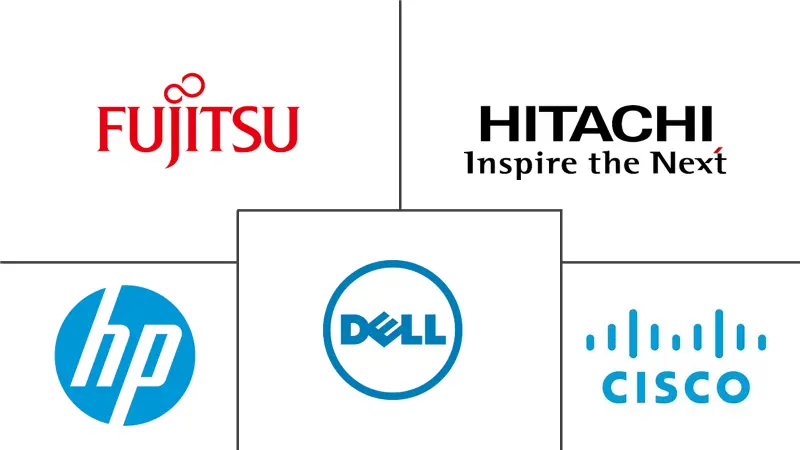Market Size of Data Center Blade Server Industry

| Study Period | 2021 - 2029 |
| Base Year For Estimation | 2023 |
| CAGR | 8.29 % |
| Fastest Growing Market | Asia-Pacific |
| Largest Market | North America |
| Market Concentration | High |
Major Players
*Disclaimer: Major Players sorted in no particular order |
Data Center Blade Server Market Analysis
The data center blade server market is expected to register a CAGR of over 8.29% over the forecast period. A blade server is a modular server compared to a rack server, which enables multiple servers to be housed in a more compact area than a rack server. These servers are designed to be thin and have only CPUs, memory, integrated network controllers, and sometimes built-in storage drives. Additionally, it consumes less power, resulting in lower operational costs. These are some of the factors driving the market for data center blade servers.
- Single or multiple server blades can be inserted or removed without distressing another running system. It reduces hardware costs, which is likely to entice industry players to adopt the technology, thereby fueling market growth.Additionally, each server blade does not consist of a distinct infrastructure and chassis, owing to which the product is relatively cheaper as compared to other solutions.
- Cloud computing is one of the industries that has had a significant impact on the data center colocation industry.The adoption of cloud computing has been proliferating over the past few years.
- Regarding the data center infrastructure, global corporations offering cloud services and third-party vendors have been identified to support their services with hyper-scale data centers and blade servers to reduce operational costs. Combining blade servers with the cloud can help reduce operational costs and increase efficiency. Cloud provider companies require private networks with high levels of bandwidth and resiliency, as well as support from a robust data center provider.
- However, when compared to rack servers, the adoption of blade servers has a higher initial cost, which limits market growth to some extent.
- With the onset of the COVID-19 pandemic, different supply chains across many industries were affected, including data center infrastructure. All major components of a data center were built off-site, delivered, and then installed, which indicates vulnerable breakage points for the market's supply chain. However, the increased cloud migrations of various industries boosted the demand for data centers in the post-Covid scenario.
Data Center Blade Server Industry Segmentation
A blade server is a small, standalone server comprised of central processing units that can fit within an enclosure with other blade servers. Blade servers are designed to overcome the space and energy restrictions of a typical data center environment. The study of the data center blade server market is limited to the types of data center blade servers offered by the vendors for application in a wide range of industries across the world.
The Data Center Blade Server Market is segmented by Data Center Type (Tier 1, Tier 2, Tier 3, Tier 4), End-user Vertical (BFSI, Manufacturing, Energy and Utility, Healthcare), and Geography (North America(United States, Canada), Europe(Germany, United Kingdom), Asia-Pacific(China, Japan, India), Latin America(Brazil, Mexico), and Middle East and Africa(United Arab Emirates, Saudi Arabia)).
The market sizes and forecasts are provided in terms of value (USD million) for all the above segments.
| Type | |
| Tier 1 | |
| Tier 2 | |
| Tier 3 | |
| Tier 4 |
| End-user Verticals | |
| BFSI | |
| Manufacturing | |
| Energy & Utility | |
| Healthcare | |
| Other End-user Verticals |
| Geography | ||||||
| ||||||
| ||||||
| ||||||
| ||||||
|
Data Center Blade Server Market Size Summary
The data center blade server market is poised for significant growth, driven by the increasing demand for efficient and cost-effective server solutions. Blade servers, known for their modular design, allow multiple servers to be housed in a compact space, offering advantages such as reduced power consumption and lower operational costs. This market is further bolstered by the rising adoption of cloud computing, which necessitates hyper-scale data centers equipped with blade servers to enhance efficiency and reduce costs. Despite the higher initial investment compared to rack servers, the cost savings and operational efficiencies offered by blade servers are attracting industry players, thereby fueling market expansion. The COVID-19 pandemic has also played a role in accelerating cloud migrations, increasing the demand for data centers and, consequently, blade servers.
In the healthcare sector, the digitization of consumer health records and the modernization of medical systems are generating vast amounts of data, driving the need for robust data center infrastructure. The evolution of digital health and telemedicine is further amplifying this demand, as real-time data processing and storage become crucial. Government initiatives, such as India's national repository for life science data, are supporting the growth of data centers, enhancing the market's prospects. The region is witnessing a shift towards cloud and network edge solutions, with significant investments in AI infrastructure to handle real-time data processing. The market is moderately consolidated, with major players like Cisco, Hewlett Packard Enterprise, and Dell continuously innovating and expanding their offerings. These developments, along with strategic partnerships and investments, are expected to sustain the market's growth trajectory over the forecast period.
Data Center Blade Server Market Size - Table of Contents
-
1. MARKET INSIGHTS
-
1.1 Market Overview
-
1.2 Industry Value Chain Analysis
-
1.3 Industry Attractiveness - Porter's Five Forces Analysis
-
1.3.1 Threat of New Entrants
-
1.3.2 Bargaining Power of Buyers/Consumers
-
1.3.3 Bargaining Power of Suppliers
-
1.3.4 Threat of Substitute Products
-
1.3.5 Intensity of Competitive Rivalry
-
-
1.4 COVID-19 Impact on the Market
-
-
2. MARKET SEGMENTATION
-
2.1 Type
-
2.1.1 Tier 1
-
2.1.2 Tier 2
-
2.1.3 Tier 3
-
2.1.4 Tier 4
-
-
2.2 End-user Verticals
-
2.2.1 BFSI
-
2.2.2 Manufacturing
-
2.2.3 Energy & Utility
-
2.2.4 Healthcare
-
2.2.5 Other End-user Verticals
-
-
2.3 Geography
-
2.3.1 North America
-
2.3.1.1 United States
-
2.3.1.2 Canada
-
-
2.3.2 Europe
-
2.3.2.1 Germany
-
2.3.2.2 United Kingdom
-
2.3.2.3 Rest of Europe
-
-
2.3.3 Asia-Pacific
-
2.3.3.1 China
-
2.3.3.2 Japan
-
2.3.3.3 India
-
2.3.3.4 Rest of Asia-Pacific
-
-
2.3.4 Latin America
-
2.3.4.1 Brazil
-
2.3.4.2 Mexico
-
2.3.4.3 Rest of Latin America
-
-
2.3.5 Middle-East & Africa
-
2.3.5.1 United Arab Emirates
-
2.3.5.2 Saudi Arabia
-
2.3.5.3 Rest of Middle-East & Africa
-
-
-
Data Center Blade Server Market Size FAQs
What is the current Data Center Blade Server Market size?
The Data Center Blade Server Market is projected to register a CAGR of 8.29% during the forecast period (2024-2029)
Who are the key players in Data Center Blade Server Market?
Cisco Systems Inc., Hewlett Packard Enterprise Co, Fujitsu Limited, Dell, Inc. and Hitachi, Limited are the major companies operating in the Data Center Blade Server Market.

